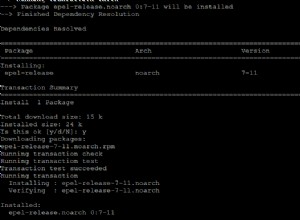Kiedy po raz pierwszy dostałem się do Node.js, Express i Mongoose, miałem problemy ze skalowaniem mojego kodu. Moją odpowiedzią jest pomoc komuś, kto pracuje nad czymś więcej niż tylko prostym blogiem, ale aby pomóc w jeszcze większym skalowalnym projekcie.
- Zawsze jestem połączony z bazą danych, nie otwieram i nie zamykam połączeń w razie potrzeby
- Używam
index.jsjako plik główny folderu, tak jak w innych językach - modele są przechowywane we własnych dokumentach, a
require()d domodels/index.jsplik. - trasy są podobne do modeli, każdy poziom trasy ma folder, w którym znajduje się
index.jsplik z kolei. Więc łatwo jest zaaranżować coś takiego jakhttp://example.com/api/documents/:id. Ma to również większy sens, gdy przechodzi się przez strukturę plików.
Oto struktura tego, czego używam:
-- app.js
-- models/
---- index.js
---- blog.js
-- mongoose/
---- index.js
-- routes/
---- index.js
---- blog/index.js
-- public/
-- views/
---- index.{your layout engine} => I use Jade.lang
-- methods/
---- index.js => use if you'd rather write all your functions here
---- blog.js => can store more complex logic here
app.js
var db = require('./mongoose'),
express = require('express');
// note that I'm leaving out the other things like 'http' or 'path'
var app = express();
// get the routes
require('./routes')(app);
// I just require routes, without naming it as a var, & that I pass (app)
mangusta/index.js
// Mongoose connect is called once by the app.js & connection established
// No need to include it elsewhere
var mongoose = require('mongoose');
mongoose.connect('mongodb://localhost/blog');
// I have just connected, and I'm not exporting anything from here
models/index.js
// Logic here is to keep a good reference of what's used
// models
Blog = require('./blog');
// User = require('./user');
// exports
exports.blogModel = Blog.blogModel;
// exports.userModel = User.userModel;
modele/blog.js
Więc dla każdego modelu, nad którym pracujesz, tworzysz plik model.js i dodaj go w models/index.js nad. Jako przykład dodałem User model, ale skomentował to.
// set up mongoose
var mongoose = require('mongoose');
var Schema = mongoose.Schema,
ObjectId = Schema.ObjectId;
var BlogSchema = Schema({
header: {type: String },
author: {type: String },
text: {type: String },
_id: { type: ObjectId } // not necessary, showing use of ObjectId
});
Blog = mongoose.model('Blog', BlogSchema);
// the above is necessary as you might have embedded schemas which you don't export
exports.blogModel = Blog;
trasy/index.js
module.exports = function(app) {
app.get('/', function(req, res) {
// do stuff
});
require('./blog')(app);
// other routes entered here as require(route)(app);
// we basically pass 'app' around to each route
}
trasy/blog/index.js
module.exports = function(app) {
app.get('/blog', function(req, res) {
// do stuff
});
require('./nested')(app);
// this is for things like http://example.com/blog/nested
// you would follow the same logic as in 'routes/index.js' at a nested level
}
sugerowane użycie
- modele:do tworzenia logiki, która zajmuje się dokumentami, tj. tworzenie, aktualizacja, usuwanie i wyszukiwanie.
- trasy:minimalne kodowanie, tylko tam, gdzie muszę przeanalizować dane http, utworzyć instancje modeli, a następnie wysłać zapytania do odpowiedniego modelu.
- metody:dla bardziej złożonej logiki, która nie obejmuje bezpośrednio modeli. Jako przykład mam
algorithms/folder, w którym przechowuję wszystkie algorytmy, których używam w mojej aplikacji.
Mam nadzieję, że zapewni to większą jasność. Ta struktura działa dla mnie cuda, ponieważ łatwo ją śledzić.




